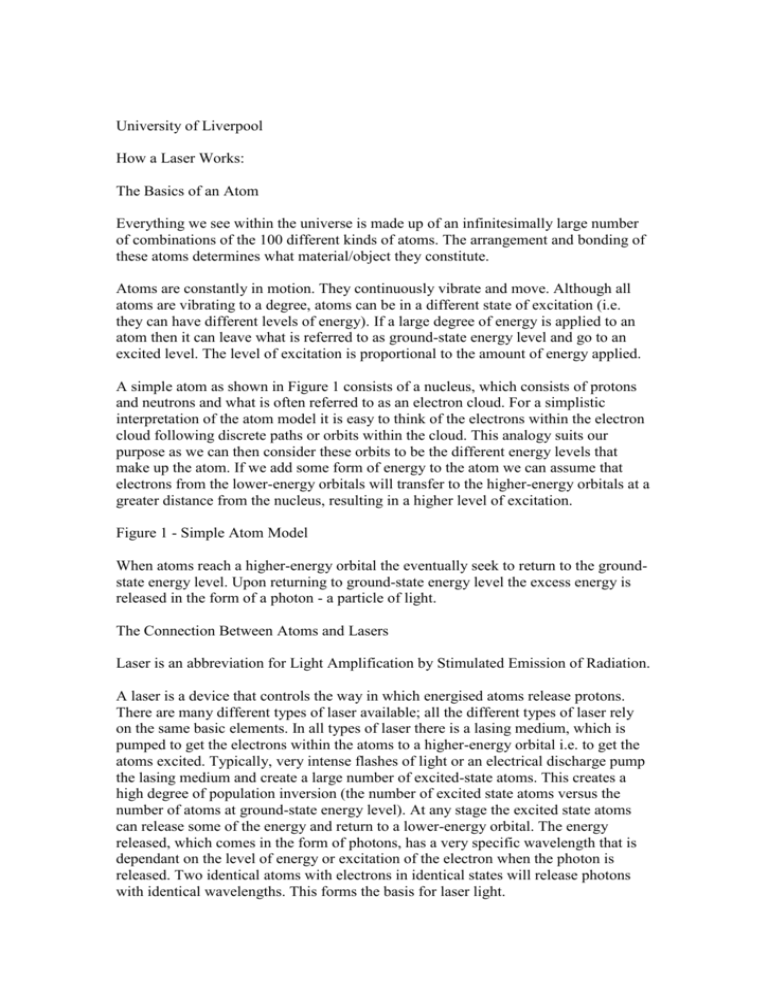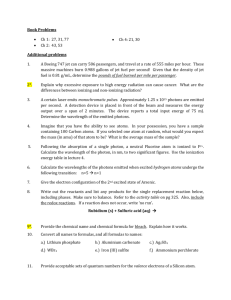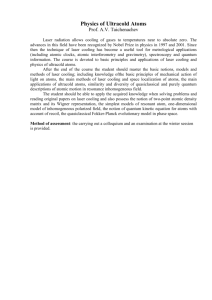laser
advertisement

University of Liverpool How a Laser Works: The Basics of an Atom Everything we see within the universe is made up of an infinitesimally large number of combinations of the 100 different kinds of atoms. The arrangement and bonding of these atoms determines what material/object they constitute. Atoms are constantly in motion. They continuously vibrate and move. Although all atoms are vibrating to a degree, atoms can be in a different state of excitation (i.e. they can have different levels of energy). If a large degree of energy is applied to an atom then it can leave what is referred to as ground-state energy level and go to an excited level. The level of excitation is proportional to the amount of energy applied. A simple atom as shown in Figure 1 consists of a nucleus, which consists of protons and neutrons and what is often referred to as an electron cloud. For a simplistic interpretation of the atom model it is easy to think of the electrons within the electron cloud following discrete paths or orbits within the cloud. This analogy suits our purpose as we can then consider these orbits to be the different energy levels that make up the atom. If we add some form of energy to the atom we can assume that electrons from the lower-energy orbitals will transfer to the higher-energy orbitals at a greater distance from the nucleus, resulting in a higher level of excitation. Figure 1 - Simple Atom Model When atoms reach a higher-energy orbital the eventually seek to return to the groundstate energy level. Upon returning to ground-state energy level the excess energy is released in the form of a photon - a particle of light. The Connection Between Atoms and Lasers Laser is an abbreviation for Light Amplification by Stimulated Emission of Radiation. A laser is a device that controls the way in which energised atoms release protons. There are many different types of laser available; all the different types of laser rely on the same basic elements. In all types of laser there is a lasing medium, which is pumped to get the electrons within the atoms to a higher-energy orbital i.e. to get the atoms excited. Typically, very intense flashes of light or an electrical discharge pump the lasing medium and create a large number of excited-state atoms. This creates a high degree of population inversion (the number of excited state atoms versus the number of atoms at ground-state energy level). At any stage the excited state atoms can release some of the energy and return to a lower-energy orbital. The energy released, which comes in the form of photons, has a very specific wavelength that is dependant on the level of energy or excitation of the electron when the photon is released. Two identical atoms with electrons in identical states will release photons with identical wavelengths. This forms the basis for laser light. Laser light has the following properties: · Laser light is monochromatic. It contains one specific wavelength of light, which as described earlier is determined by the amount of energy released when the electron drops to a lower-energy orbital. · Laser light is coherent. Each proton moves in step with the other (i.e. all protons have wave fronts that move in unison). · Laser light is highly directional (i.e. a laser beam is very tight and concentrated To ensure the aforementioned properties are apparent within the laser light the process briefly mentioned earlier, 'stimulated emission' must occur. Any photon that has been released by an atom, (which therefore has a wavelength, phase and energy level dependant on the difference between the excited atom state and the ground-state energy level) should encounter another atom that has another electron in the same excited state, stimulated emission can occur. The first photon can stimulate or induce atomic emission so that the emitted photon vibrates with the same frequency and direction. To produce laser light it is necessary to have a pair of mirrors at either end of the lasing medium. These mirrors are often known as an optical oscillator due to the process of oscillating photons between the two mirrored surfaces. The mirror positioned at one end of the optical oscillator is half-silvered, therefore it reflects some light and lets some light through. The light that is allowed to pass through is the light that is emitted from the laser. During this process photons are constantly stimulating other electrons to make the downward energy jump, hence causing the emission of more and more photons and an avalanche effect, leading to a large number of photons being emitted of the same wavelength and phase. Below is a graphical illustration of what has been detailed above. The graphics illustrate how laser light is created using a ruby laser, the first fully functioning laser. Theodore Maiman invented the ruby laser on May 16th 1960 at the Hughes Research Laboratories (for more information on dates relating to laser invention see a Brief History of Lasers). Figure 2 - Schematic of Laser in Non-Lasing State Figure 3 - Schematic Illustrating the Excitation of Atoms Using Light Source Figure 4 - Schematic Showing Photon Emission Figure 5 - Schematic Showing the Stimulated Emission of Further Photons Figure 6 - Schematic Showing Column of Laser Light Leaving Optical Oscillator






